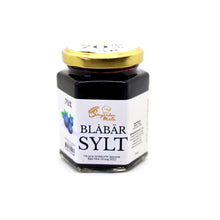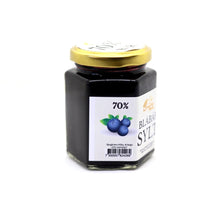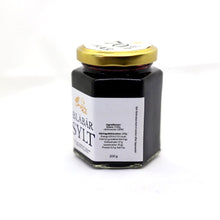
A luxurious berry-rich blueberry preserve
Blueberries are amazingly tasty and one of the most common plants in Sweden. Blueberry rice covers approximately 17 percent of Sweden's surface. It thrives best in spruce forests. Many of the forest's inhabitants go there in the summer to eat the delicious berry - among others bears, foxes, badgers, grouse and grouse. Deer and moose prefer the rice itself. Blueberries (Vazzinium myrtillus) grow wild in most of Europe, but not in the Mediterranean area. It should not be confused with American blueberry (Vaccinium corymbosum and V. angustifolium), which are other species in the genus. In English, the European blueberry is called bilberry. Botanically, blueberry is a dwarf tree with a main trunk and branches that form a crown of leaves. The branches are angular and the leaves are ovate and serrated. The blueberry is related to plants such as rhododendron and azalea.
Blueberries are useful in several ways. It counteracts memory loss. A study on mice has shown that the berry promotes the brain cells' ability to communicate with each other. It is also considered good for the eyesight and the stomach. In addition, it contains beneficial antioxidants. As well as vitamin C.
Blueberries can be used in many different ways in cooking. Pie, juice, jam, marmalade, cream and soup are some examples. In addition, blueberries are many people's favorite as natural in yogurt or milk. Blueberries can also be used in the dyeing of wool and veneer. You should not rinse your blueberries. At least not until right before you eat them. The water causes the berries to soften and quickly spoil. And you want to avoid that.
Blueberry flavor in processed foods often does not contain blueberries, but the flavor is produced with a combination of sugar, corn syrup, starch, oil and artificial flavors and colors. Doesn't sound that cool. The real thing always tastes best.
The term blueberry used for beginners or amateurs in sports originates from the 1960s. Less skilled skiers in the Vasaloppet liked to stop at the blueberry soup stations and spill a little at each opportunity so that they looked like blueberries at the finish line.
Blueberry rice is about 30 cm high, exceptionally up to 70 cm. Blueberries are normally coated with a thin layer of wax, which protects the berry from moisture and dehydration and gives them a dull, pale blue color. Fully ripe blueberries have a juicy pulp, which, despite the plant's name, is dark burgundy. The taste is sweet with insignificant acidity.
Blueberries contain antioxidants, including 8 mg of ascorbic acid per 100 g (recommended daily requirement 75 – 100 mg). The nutritional content of the berries is low, and as survival food it is mainly the liquid content that is of value.
Blueberries - that's why they're so healthy
Blueberries are so good! Blueberries are not only beautiful and tasty, they are also healthy. Full of vitamins and good for the stomach. And think how much you can do with them! Pies, muffins, cheesecake, pancakes, sponge cake, smoothies...
But it's not just yummy to eat, the blue berries are actually really good for you too.
The reason? There are plenty of flavonoids in blueberries – a substance that can reduce the risk of several different diseases.
Ingredients : Blueberries (70%), raw cane sugar (30%)
Nutrition declaration 100g: Energy 633 kJ/151 kcal; Fat 0.2 g (saturated fat 0 g); Carbohydrates 37 g (sugars 35 g); Protein 0.5 g; Salt 0 g













